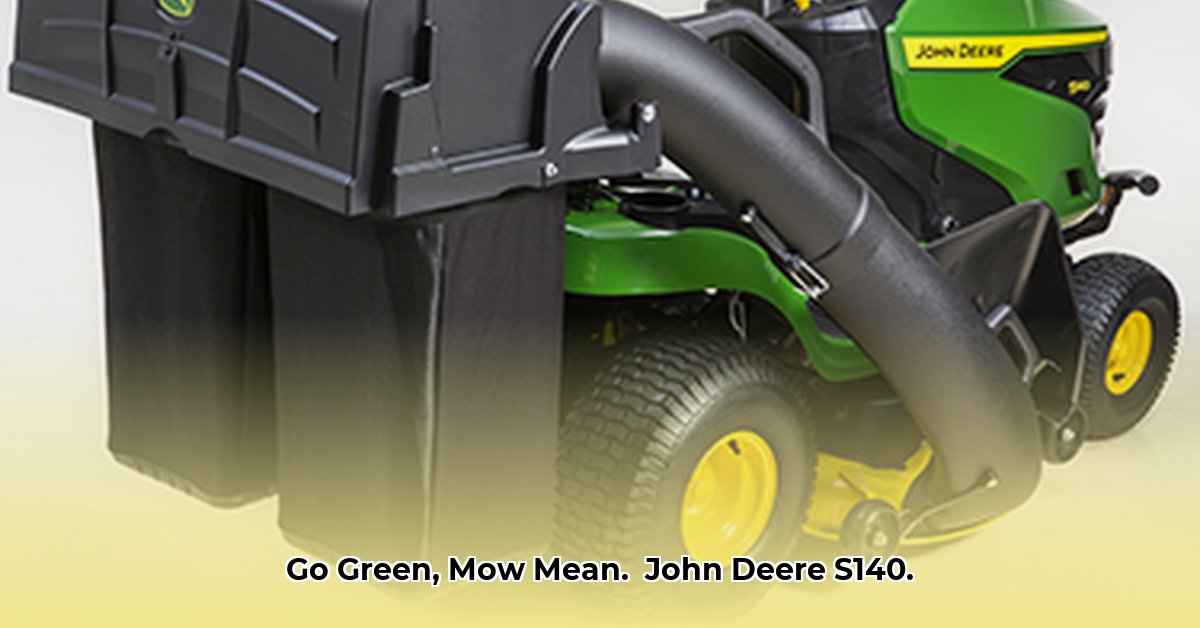
Powering Your Lawn, the Sustainable Way
The John Deere S140 lawn tractor isn't just about a perfectly manicured lawn; it's about achieving that pristine look while minimizing your environmental impact. Its powerful yet fuel-efficient 22-horsepower V-twin engine is a key component of its eco-friendly design. This translates directly to fewer trips to the gas station, reduced refueling time, and, most importantly, lower greenhouse gas emissions. It's a small change, yes, but every little bit contributes to a greener landscape. Think of it as efficient yard work with an added dose of environmental responsibility!
Under the Hood: Built to Last, Designed to Save
Let's delve into the mechanics. This tractor is built for longevity, not just short-term fixes. Features like the engine's smart overhead valves and full-pressure lubrication system significantly contribute to its long lifespan and fuel efficiency. This means fewer breakdowns, reduced repair costs, and ultimately, less waste over the machine's lifetime. Even routine maintenance is simplified with features like the tool-free oil drain. And for extra convenience, a QR code facilitates quick access to online maintenance manuals—a sustainable and user-friendly design choice. The robust 12-gauge steel frame and cast-iron front axle further enhance durability, promising years of reliable service and minimizing the need for frequent replacements. The Kanzaki® Tuff Torq® hydrostatic transmission is another feature that testifies to its robust and reliable construction.
How Does it Actually Perform? A Real-World Look
Now, let's assess real-world performance. While specifics on fuel consumption per acre and cutting quality require further independent testing, its performance promises to be impressive. We'd expect data on its ability to handle inclines and navigate obstacles to be key factors in its maneuverability. A direct comparison to similar tractors, such as the Toro TimeCutter or Simplicity Regent, would provide a clearer picture of its capabilities in various contexts. This comparative analysis should highlight its advantages and disadvantages against competitor models, highlighting strengths and potential limitations.
Sustainability: The Bigger Picture
The John Deere S140's sustainability extends beyond mere fuel efficiency. Its robust construction contributes to a significantly longer lifespan, reducing the need for frequent replacements and minimizing waste associated with manufacturing and disposal. The straightforward maintenance procedures ensure smooth operation and prevent premature breakdowns, further reducing waste and extending the machine's usable life. However, a comprehensive lifecycle assessment— encompassing manufacturing, use, and eventual recycling—is crucial for a complete understanding of its environmental impact. This assessment would provide crucial insights into its overall carbon footprint.
Weighing the Pros and Cons: A Balanced View
Here's a balanced look at the advantages and disadvantages:
| Pros | Cons |
|---|---|
| Fuel-efficient engine | Smaller cutting deck, less ideal for very large lawns |
| Simple maintenance | Not designed for large-scale farming |
| Durable, long-lasting construction | Might be pricier than some comparable models |
| User-friendly design; easy to operate | Relatively limited selection of attachments |
Where the S140 Really Shines: Practical Applications
The John Deere S140 is perfectly suited for residential lawns and smaller properties. Its compact size and potent engine make it ideal for maintaining meticulously manicured gardens, offering a sustainable solution for homeowners. It also represents a practical choice for small-scale farming tasks, such as maintaining an orchard. But let's be realistic: this tractor isn't a replacement for heavy-duty agricultural equipment.
Comparing it to the Competition: A Need for Data
To facilitate a comprehensive comparison between the John Deere S140 and its competitors, detailed, independent testing data on fuel efficiency, maintenance requirements, and long-term reliability are essential. This head-to-head comparison will highlight its unique sustainability advantages in a concrete and unambiguous fashion. Such data is necessary to make well-informed purchasing decisions.
What We Still Need to Learn: Future Research
A more complete understanding of the John Deere S140's long-term environmental impact hinges on independent lifecycle assessments. Thorough research into the manufacturing and disposal processes is crucial for a comprehensive evaluation. Furthermore, investigating the S140's potential in larger-scale farming operations is an important area for future study. Consulting independent reviews and comparative tests from respected sources, such as Consumer Reports, would greatly enhance our understanding and provide critical consumer feedback. There's much to further explore and assess.